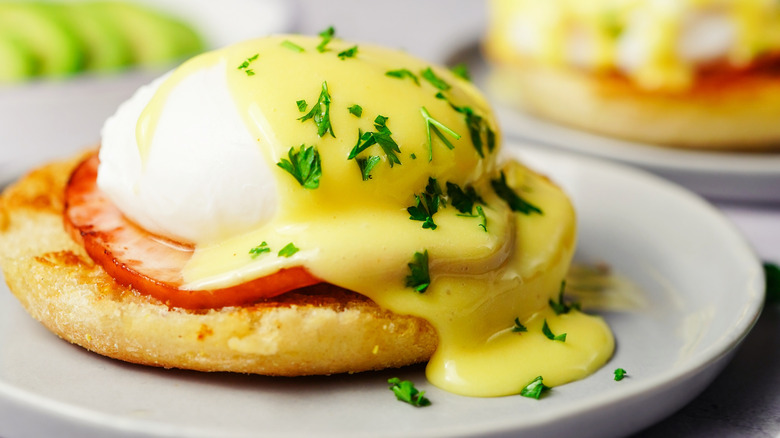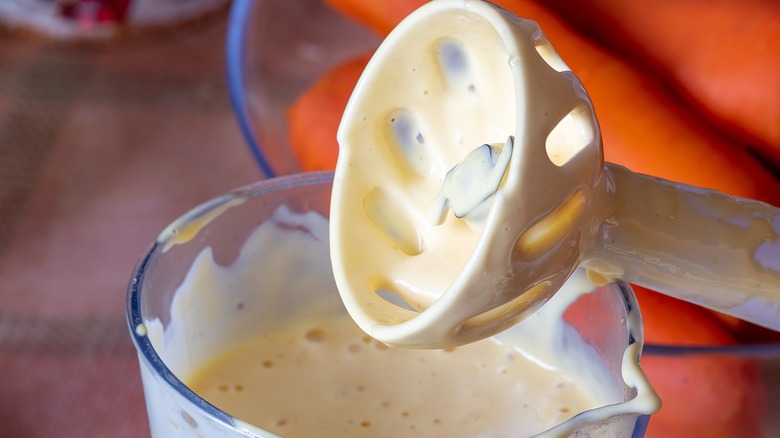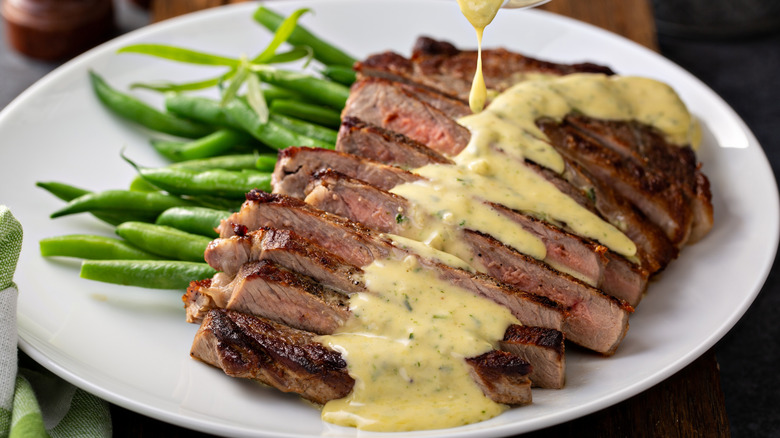Believe It Or Not, You Can Make Hollandaise Sauce In 1 Minute
Hollandaise has a reputation for being a fussy sauce to make; it can be tough to get right. When you do, it must be maintained at a perfect temperature to keep from breaking. The classic technique requires almost three hands, one to steady the double boiler, a second to whisk, and the third for drizzling in the melted butter.
If you get it right, though, the reward is massive. Hollandaise is a warm sauce that uses egg yolk and a bit of acid to keep melted butter emulsified. It's the perfect, rich-yet-tangy sauce for asparagus, artichokes, or poached salmon. It has a long history in French cuisine, where it's one of the five mother sauces, meaning that there's an entire family tree of sauces that can be derived from these essential recipes.
In the end, you have the key ingredient to the brunch staple that Duff Goldman calls the best ever made. Without hollandaise, eggs benedict is just an open-faced sandwich; with it, it's the pinnacle of brunch menus everywhere. Since most of us aren't grizzled brunch cooks, any help we can get to make our own batch of hollandaise is more than welcome.
Blender hollandaise
Thomas Keller's traditional method for making hollandaise is available from MasterClass. He certainly makes that look easy. After all, he holds seven Michelin stars, the most of any American chef. When creating Keller's — or any — version of this recipe, most of us will struggle to balance the proper heat, the correct speed, and precise amounts of ingredients. If you attempt to make hollandaise, how many recipes include directions for how to fix them should things go awry
For the record, a broken hollandaise is when the emulsion fails, and the butter separates from the eggs. If you see an oil slick on the top of the sauce, it's breaking. To fix this, heat the sauce until it entirely separates into oil, with clumps of yolk. Slowly drizzle this hot mixture into another egg yolk to reset the emulsion.
Blender hollandaise uses the force of an electric motor to speed up the process and widen the margin of error. Martha Stewart blends egg yolks, lemon juice, and kosher salt. As soon as one stick of butter is melted, drizzle it slowly into the running blender or a tall, narrow container using an immersion blender. Go slow; that drizzle should take close to a minute to pour. That's all there is to it. Pour this into a container and cover it to keep it warm for up to 30 minutes. Stewart recommends whisking in a tablespoon of water if it becomes too thick.
Microwaved hollandaise
Suppose drizzling hot butter into a blender still sounds like too much; good news! You can make a virtually hands-free hollandaise in the microwave. Once the ingredients are combined, it only takes a minute of microwaving.
For this easy way to make hollandaise, 40 Aprons microwaves a stick of butter until it's almost melted. Remove from the bowl from the microwave and stir the butter until it's fully melted. Then, add yolks, heavy cream, and lemon juice. Stir this to combine and microwave for 20 seconds before removing to stir once again. Repeat this a few more times until the sauce thickens. Check the seasoning for more lemon juice and salt. Hollandaise purists might balk at the inclusion of cream, saying it could dull the sauce's flavor, but it's also insurance for not breaking the sauce. That seems like a fair trade-off.
There's no reason to think you couldn't use white wine vinegar instead of lemon juice and add some fresh tarragon at the end for a quick bearnaise sauce, one of the better-known hollandaise derivatives. A microwave is another tool in your sauce-making arsenal.
Both of these more accessible hollandaise techniques work well. All the grandeur, richness, and velvety smooth texture of traditionally made sauce can be available in less time than it takes to simmer a batch of powdered hollandaise sauce mix.


